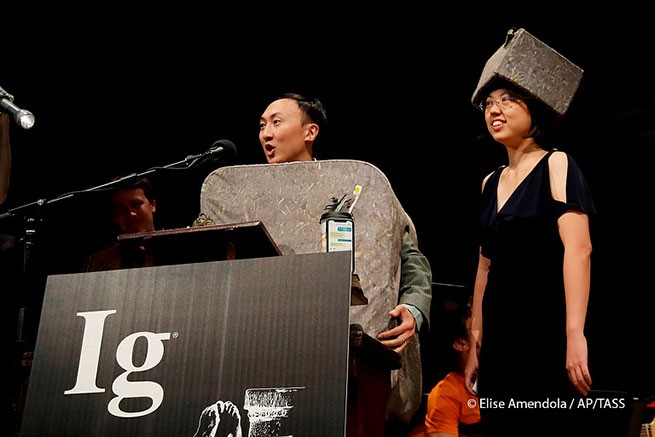Scientific studies of dead trout, coin tossing, drunk worms, paper bags exploding next to a cat standing on a cow's back and the effect of stress on milk production have also won awards for seriously funded fun research.
The award ceremony was held at the Massachusetts Institute of Technology «Ig Nobel Prize», famous “Ig Nobel Prizes” in different fields of science. As he writes The Guardianthe event was attended by real Nobel laureates, who, in particular, handed out prizes.
Initially, this award was conceived as a parody of the “Nobel Prize”, and as a cash prize the winners receive 100 trillion Zimbabwean dollars (which in total equals several dollars). The award «Ig Nobel Prize» does not mean that the scientist has conducted stupid or unnecessary research: the main thing is that his topic or conclusion sounded like a joke. Sometimes the prize goes to outright charlatans and pseudoscientists, but this happens rarely, “Ig Nobel laureates” treat themselves and their work with irony. In 2024, 10 winners will be announced:
- “Ig Nobel Prize in Physiology” was awarded to Ryo Okabe and colleagues for showing that many animals can breathe through their anuses, a dramatic demonstration that breakthroughs can come from the most unlikely of places. The research was linked to the COVID-19 pandemic and the surge of patients requiring ventilators. In a series of experiments on mice, rats and pigs, the Japanese scientists found that the animals absorbed oxygen delivered through the rectum, paving the way for clinical trials to see if the procedure could be used to treat respiratory failure. As it turns out, both methods work and are able to prevent the animal from suffocating without serious complications. Whether humans can breathe through their anuses is still unknown. However, judging by the enthusiasm at receiving the award, scientists will definitely find out.
- “Ig Nobel Peace Prize” awarded to the late B. F. Skinner, an American psychologist, for his investigation of the possibility of placing live pigeons inside rockets to guide them to their targets. The project, which Skinner himself called “crazy” was cancelled despite an excellent demonstration involving a pigeon trained on a target off the New Jersey coast. “The spectacle of a live pigeon performing its task, however beautifully, merely reminded the committee how fantastic our proposal was,” Skinner wrote.
- “Ig Nobel Prize in Botany” awarded to Jacob White (USA) and Felipe Yamashita (Germany) for their report that a South American plant Boquila trifoliolata Maybe imitate leaves of plastic plantsnext to which it is located, which allows us to conclude that the “seeing plants” hypothesis is plausible.
- “Ig Nobel Prize in Anatomy” was awarded to Marjolene Willems, who studied the direction in which the hair pattern of people in the Southern and Northern Hemispheres curls. The study found that twins have hair curled in the same direction, while children from the Southern Hemisphere have hair curled counterclockwise.
- “Ig Nobel Prize in Medicine” received by groups of Swiss, Germans and Belgians for demonstrating that Fake drugs that cause painful side effects may be more effective for patients than counterfeit drugs that do not cause them.
- The Ig Nobel Prize in Physics was awarded to James Liao of the University of Florida for comprehensive repeatedly published study swimming abilities of dead trout.
- “Ig Nobel Prize in Probability Theory” was obtained by a team of 50 researchers, mostly Dutch, who flipped 350,757 coins to test a hypothesis put forward by Persi Diaconis, a former magician and statistics professor at Stanford University. Their work confirmed the prediction of Deaconess that tossed coins (with a small probability) land the same way they were started.
- “Ig Nobel Prize in Chemistry” received by the team from Amsterdam, it used chromatography to separation of drunk and sober wormsall in the name of polymer science. They had previously tested the effects of cannabis on the same worms, but were not awarded the prize because of the importance of the research to Dutch society.
- “Ig Nobel Prize for Demography” Saul Justin Newman received the results. He found that a significant number of centenarians are found in regions where documentation of birth and death dates is poor.
- “Ig Nobel Prize in Biology” – another posthumous Ig Nobel award in biology, awarded to the late Fordyce Ely and William Petersen for their 1940 research factors affecting milk production in dairy herdsThe authors of an article in the Journal of Animal Science described how they put a cat on a cow's back and repeatedly blew up paper bags to see if the milk flow would change. It turned out that cows that were scared produced less milk. “The scare initially involved placing a cat on a cow's back and exploding paper bags every 10 seconds for two minutes, – the researchers write. – Later, the cat was discarded as an unnecessary thing.”.







More Stories
Pope refuses to celebrate first mass at restored Notre Dame Cathedral in Paris
New illumination of the Temple of Poseidon at Cape Sounion (video)
Greek monk warns of internet speculation surrounding Athos services